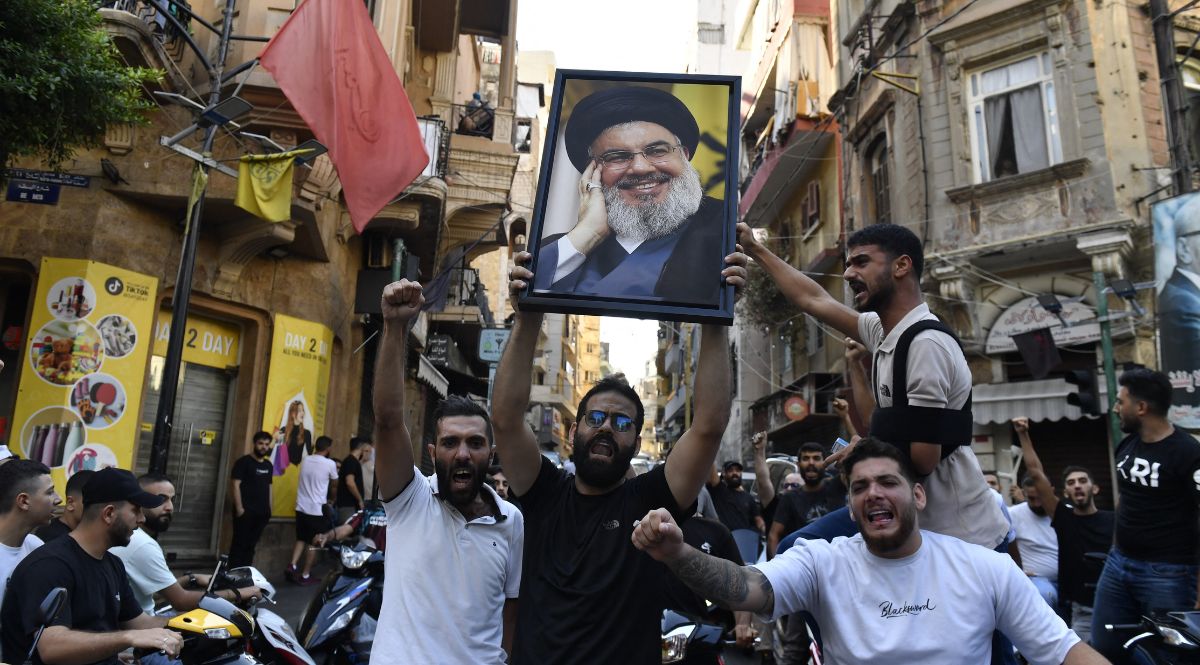A Year of War: Israel's Domestic and International Situation Coarsening
After a year of war with Hamas and confrontation with the Iranian-led “Axis of Resistance”, Israel remains in a political crisis despite military successes. The expansion of its armed forces’ operations into Lebanon and continued presence in the Gaza Strip is degrading Israel’s relations with its main allies. Although Prime Minister Benjamin Netanyahu has stabilised his position as the head of government, the perception of the Israeli public and foreign partners is that his policies are helping to prolong the crisis in the region.
.png) Violeta Santos Moura / Reuters / Forum
Violeta Santos Moura / Reuters / Forum
Many Fronts
A year after the 7 October Hamas attack and the start of the Israeli ground invasion, the war in Gaza remains at high intensity. Urban fights are again taking place in the northern part, while operations and airstrikes are being conducted in virtually every area of the Strip. The Israeli army maintains a permanent presence on the border with Egypt (the so-called Philadelphia corridor) and along the Netzarim Corridor in the middle of the strip, and has also destroyed Palestinian border infrastructure to create a buffer zone. Hamas forces, although severely weakened, have not been broken and maintain the ability to return to lost areas or to launch rocket attacks, albeit sporadic. At the same time, Israel has succeeded in eliminating the organisation’s leadership—Chairman Ismail Haniyeh in July this year and his successor and the organisation’s leader in Gaza, Yahya Sinwar, in October this year. Israel confirmed the death of military leader Muhammed Deif in July, but Hamas denies it. So far, the number of Palestinian casualties, according to the U.N. based on data from the Palestinian Ministry of Health, is about 43,000 dead (civilians and militants) and about 100,000 wounded. The humanitarian crisis among the civilian population continues at an extremely high level.
The Israeli military effort is now focused on the war against Hezbollah. Israel is continuing its ground operation in southern Lebanon along with airstrikes on the organisation’s infrastructure, including targets in Beirut. At the same time, Hezbollah, despite heavy losses including the death of leader Hassan Nasrallah, the loss of senior command staff, and the destruction of part of its arsenal, maintains response capabilities, in part by expanding its rocket fire or launching precision drone attacks, including on Israeli army bases. Additional point threats include attacks from other directions, such as Yemen, Iraq, and Syria, from where several hundred missiles and drones have been launched at Israel since the war began. There are also ongoing clashes in West Bank cities. There were direct Iranian missile attacks on Israel in April and October, the last of which Israel responded to with a raid on 26 October.
Political and Social Situation
Tactical military successes in recent months, especially the elimination of Hamas and Hezbollah leaders, have strengthened Prime Minister Netanyahu. He expanded his parliamentary majority from 64 to 68 deputies in September this year after the right-wing New Hope coalition led by Gideon Saar joined. The move strengthened Netanyahu’s position primarily vis-à-vis opponents from his home Likud party, such as Defence Minister Yoav Gallant, who is in conflict with the prime minister. Despite fierce friction with fellow coalition partners from the far-right or religious parties, the option of leaving the government is politically unviable for them and remains unlikely. However, a rupture in voting discipline cannot be ruled out if their demands, such as halting conscription among the ultra-Orthodox population, are not implemented. Despite the current government coalition’s recovering support, polls indicate that it would lose its majority in the Knesset in snap elections. Still, the opposition’s eventual formation of a government would require nearly all constituent groups to agree. Also contributing to the deepening political crisis is the return of previously suspended reforms and measures increasing politicians’ control over the judiciary, including the justice minister’s obstruction of the selection of the head of the Supreme Court. State investigations into settlements on the political-military side over the Hamas attack of 7 October 2023 have still not begun.
The year of war has deepened social polarisation in Israel in traditional areas (between the secular and religious populations, the Jewish majority and the Arab minority, vis-à-vis the Jewish settlements) and disputes along citizen-government lines. Currently, the primary and most mobilising issue of opposition to the Netanyahu government is the fate of the remaining 101 hostages still held captive by Hamas in Gaza (about a third have been confirmed dead). Their safety in the view of the majority of the Israeli public (53%) is the main argument for ending the fighting in Gaza. At the same time, the war has deepened Israelis’ opposition to independence aspirations and extreme mistrust of Palestinians.
Destabilising activities continue from the far-right, manifested by attacks on services involved in the investigation of the mistreatment of detained Hamas members, settlement violence and calls for the re-occupation of the Gaza Strip, among others. The war against Hezbollah in Lebanon enjoys greater support among the Israeli public (80%). It is seen as the most effective means of ensuring the return of civilians to the north of the country.
Peace Talks and External Aspects
Continuing the fight against Hamas and Hezbollah is, according to the Netanyahu government, crucial to achieving immediate Israeli political-military goals (release of hostages, return of internally displaced persons) and strategic goals (combating Iranian influence). The effectiveness of this strategy in Gaza has so far proved limited. Negotiations for the release of the hostages have been at an impasse since September due in part to Israeli demands to maintain control of the border with Egypt. However, Israel hopes that after Sinwar’s death, Hamas may partially revise its position. At the same time, a plan for the post-war administration of Gaza has still not been presented, and the Israeli government officially rejects the option of returning Gaza to the structures of the Palestinian Authority. In the conflict with Hezbollah, in addition to seeking to weaken the organisation as much as possible, Israel wants the organisation to abandon making a ceasefire in Lebanon conditional on the end of fighting in Gaza. At the same time, Israel’s position is to maintain operational freedom, which strikes at the durability of any potential truce. The humanitarian situation and public services in the Palestinian territories will be negatively impacted by Israel’s 28 October ban on operations and the severance of cooperation with the UNRWA agency.
The protracted hostilities, the resulting rising costs on the part of Palestinian and Lebanese civilians, the rhetoric of the far-right, and the risk of escalation with Iran are generating increasingly strident criticism of Israel from European and Middle Eastern countries. The Israeli military’s actions against UNIFIL, stationed in southern Lebanon, including incidents of shelling amid demands for the peacekeeping force to leave, has sparked particularly fierce diplomatic protests, including from the governments of France and Italy. Calls and actions for an arms embargo with Israel are gaining momentum, although relatively still limited, but calls include demands by Germany or Italy for the suspension of export licenses by the U.K. A key factor remains the stance of the United States, which has threatened restrictions on arms supplies unless there is a improvement in the humanitarian situation in northern Gaza, for example. However, the Biden administration’s pressure on Israel is influenced by calculations about next week’s U.S. presidential elections. At the same time, allied support in the operational domain has been maintained, including assistance in countering the Iranian mass missile attack.
Conclusions and Outlook
Israel has succeeded in effectively weakening two of the terrorist groups most dangerous to it, but an end to hostilities is unlikely any time soon. The Israeli authorities see the continuation of the fighting as a chance to restore the deterrence potential lost after 7 October and to weaken Iran’s regional capabilities. For Prime Minister Netanyahu, maintaining the war is the most effective means for rebuilding his domestic position. However, the failure in the short term to translate military successes into the realisation of stated political goals, along with the increasing costs of waging war on the socio-economic level, threatens to increase Israel’s internal crisis. In addition, the continuation of military operations in their current form and the ever-increasing number of civilian casualties are raising increasingly strong objections from the international community and deepening the diplomatic isolation of the Israeli government.
An essential reference point for Israel’s further calculations will be the outcome of the U.S. elections. At the same time, regardless of who becomes president, more substantial U.S. pressure—supported by the region’s countries—for a cessation of hostilities is likely. Implementing a political plan for the future of Gaza remains a prerequisite for the future stabilisation of the security situation in the region, as well as some level of de-escalation in the confrontation with Iran.



.png)

.jpg)